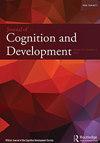动作表征之间的竞争如何影响发展过程中的物体感知
IF 2.1
2区 心理学
Q3 PSYCHOLOGY, DEVELOPMENTAL
引用次数: 2
摘要
最近在成年人中的证据表明,物体感知处理受到动作表征之间竞争的影响。在没有特定运动计划的情况下,与不同的结构(抓握)和功能(使用)动作(如计算器)相关的可到达物体比与类似动作(如球)相关的物体引发的判断更慢。这种影响被认为反映了诉讼陈述之间的冲突所带来的成本。本研究旨在确定这种冲突成本与年龄相关的变化,并研究其潜在机制。从8岁到成年的五个年龄组参与了研究(n=119)。参与者在虚拟环境中对不同的3D对象进行感知判断,以评估他们的冲突成本(实验1)。在同一参与者中,动作启动效应和西蒙效应分别作为激活动作表征和监控冲突能力的独立指标进行了进一步评估(实验2和3)。实验1表明,冲突成本存在于8岁以下的儿童中,并在8岁至成年期间遵循非线性的U型发展轨迹。实验2和3表明,动作启动效应显示出类似的U形曲线,而西蒙效应在各个年龄组之间是稳定的。行动启动效应进一步预测冲突成本为10。结果表明,冲突成本依赖于激活视觉对象的动作表征的能力,而视觉对象在青春期早期经历了重要的变化。一般冲突监测能力在冲突成本发展中的作用需要进一步调查。研究结果将推动行动选择模型和具体的发展观。本文章由计算机程序翻译,如有差异,请以英文原文为准。
How Competition between Action Representations Affects Object Perception during Development
ABSTRACT Recent evidence in adults indicates that object perceptual processing is affected by the competition between action representations. In the absence of a specific motor plan, reachable objects associated with distinct structural (grasping) and functional (using) actions (e.g., calculator) elicit slower judgments than objects associated with similar actions (e.g., ball). This effect is believed to reflect the cost entailed by the conflict between action representations. The present study aims to identify age-related changes in this conflict cost and investigate its underlying mechanisms. Five age groups from 8 to adulthood participated (n = 119). Participants performed perceptual judgments on different 3D objects in a virtual environment in order to assess their conflict cost (Experiment 1). Action priming effects and Simon effects were further assessed in the same participants as independent indices of the ability to activate action representations and to monitor conflict, respectively (Experiments 2 and 3). Experiment 1 demonstrated that the conflict cost is present in children as young as 8 and follows a non-linear, U-shaped developmental trajectory between 8 and adulthood. Experiments 2 and 3 indicated that action priming effects showed a similar U-shaped curve, whereas Simon effects were stable across age groups. Action priming effects further predicted conflict costs at 10. Results suggest that the conflict cost relies on the ability to activate action representations from visual objects, which undergoes important changes during early adolescence. The role of general conflict monitoring abilities in conflict cost development requires further investigation. The findings will fuel models of action selection and embodied views of development.
求助全文
通过发布文献求助,成功后即可免费获取论文全文。
去求助
来源期刊

Journal of Cognition and Development
Multiple-
CiteScore
4.00
自引率
0.00%
发文量
29
期刊介绍:
The Journal of Cognition and Development is the official journal of the Cognitive Development Society (CDS). Some CDS members are concerned with basic research or theory; others focus on policy issues and practical applications. The range of interests includes cognitive development during all stages of life, and we seek to understand ontogenetic processes in both humans and nonhumans. Finally, their interests encompass typical as well as atypical development, and we attempt to characterize both biological and cultural influences on cognitive change and continuity.
 求助内容:
求助内容: 应助结果提醒方式:
应助结果提醒方式:


